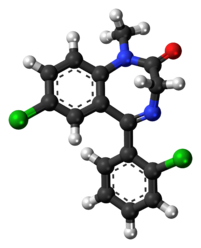Diclazepam
 | |
 | |
| Clinical data | |
|---|---|
| Routes of administration | Oral, sublingual |
| Legal status | |
| Legal status |
|
| Pharmacokinetic data | |
| Bioavailability | ? |
| Metabolism | Hepatic |
| Elimination half-life | ~42 hours[2] |
| Excretion | Renal |
| Identifiers | |
| |
| CAS Number | |
| PubChem CID | |
| ChemSpider | |
| UNII | |
| KEGG | |
| CompTox Dashboard (EPA) | |
| Chemical and physical data | |
| Formula | C16H12Cl2N2O |
| Molar mass | 319.19 g·mol−1 |
| 3D model (JSmol) | |
| |
| |
| | |
Diclazepam (Ro5-3448), also known as chlorodiazepam and 2'-chloro-diazepam, is a benzodiazepine and functional analog of diazepam. It was first synthesized by Leo Sternbach and his team at Hoffman-La Roche in 1960.[3] It is not currently approved for use as a medication, but rather sold as an unscheduled substance.[4][5][6][7] Efficacy and safety have not been tested in humans.
In animal models, its effects are similar to diazepam, possessing long-acting anxiolytic, anticonvulsant, hypnotic, sedative, skeletal muscle relaxant, and amnestic properties.[citation needed]
Metabolism
Metabolism of this compound has been assessed,[2] revealing diclazepam has an approximate elimination half-life of 42 hours and undergoes N-demethylation to delorazepam, which can be detected in urine for 6 days following administration of the parent compound.[8] Other metabolites detected were lorazepam and lormetazepam which were detectable in urine for 19 and 11 days, respectively, indicating hydroxylation by cytochrome P450 enzymes occurring concurrently with N-demethylation.
Legal status
United Kingdom
In the UK, diclazepam has been classified as a Class C drug by the May 2017 amendment to The Misuse of Drugs Act 1971 along with several other benzodiazepine drugs.[9]
United States
On December 23, 2022, the DEA announced it had begun consideration on the matter of placing Diclazepam under temporary Schedule I status.[10]
Later on July 25, 2023, the DEA published a pre-print notice that Diclazepam would become temporarily scheduled as a Schedule I controlled substance from 07/26/2023 to 07/26/2025.[11]
See also
- Diazepam
- Difludiazepam
- Delorazepam (Nordiclazepam)
- Lorazepam
- Phenazepam
- Ro09-9212
- Ro5-4864 (4'-Chlorodiazepam)
- Ro07-5220 (6'-Chlorodiclazepam)
References
- ^ Anvisa (2023-03-31). "RDC Nº 784 - Listas de Substâncias Entorpecentes, Psicotrópicas, Precursoras e Outras sob Controle Especial" [Collegiate Board Resolution No. 784 - Lists of Narcotic, Psychotropic, Precursor, and Other Substances under Special Control] (in Brazilian Portuguese). Diário Oficial da União (published 2023-04-04). Archived from the original on 2023-08-03. Retrieved 2023-08-16.
- ^ a b Moosmann B, Bisel P, Auwärter V (July–August 2014). "Characterization of the designer benzodiazepine diclazepam and preliminary data on its metabolism and pharmacokinetics". Drug Testing and Analysis. 6 (7–8): 757–763. doi:10.1002/dta.1628. PMID 24604775.
- ^ US 3136815, "Amino substituted benzophenone oximes and derivatives thereof"
- ^ Pettersson Bergstrand M, Helander A, Hansson T, Beck O (April 2017). "Detectability of designer benzodiazepines in CEDIA, EMIT II Plus, HEIA, and KIMS II immunochemical screening assays". Drug Testing and Analysis. 9 (4): 640–645. doi:10.1002/dta.2003. PMID 27366870.
- ^ Høiseth G, Tuv SS, Karinen R (November 2016). "Blood concentrations of new designer benzodiazepines in forensic cases". Forensic Science International. 268: 35–38. doi:10.1016/j.forsciint.2016.09.006. PMID 27685473.
- ^ Manchester KR, Maskell PD, Waters L (March 2018). "Experimental versus theoretical log D7.4 , pKa and plasma protein binding values for benzodiazepines appearing as new psychoactive substances". Drug Testing and Analysis. 10 (8): 1258–1269. doi:10.1002/dta.2387. PMID 29582576.
- ^ Manchester KR, Waters L, Haider S, Maskell PD (July 2022). "The blood-to-plasma ratio and predicted GABAA-binding affinity of designer benzodiazepines". Forensic Toxicology. 40 (2): 349–356. doi:10.1007/s11419-022-00616-y. PMC 9715504. PMID 36454409. S2CID 247455284.
- ^ Bareggi SR, Truci G, Leva S, Zecca L, Pirola R, Smirne S (1988). "Pharmacokinetics and bioavailability of intravenous and oral chlordesmethyldiazepam in humans". European Journal of Clinical Pharmacology. 34 (1): 109–112. doi:10.1007/bf01061430. PMID 2896126. S2CID 1574555.
- ^ "The Misuse of Drugs Act 1971 (Amendment) Order 2017".
- ^ "(Proposed Rule) Schedules of Controlled Substances: Temporary Placement of Etizolam, Flualprazolam, Clonazolam, Flubromazolam, and Diclazepam in Schedule I". Federal Register. DEA. December 23, 2022.
- ^ "Schedules of Controlled Substances: Temporary Placement of Etizolam, Flualprazolam, Clonazolam, Flubromazolam, and Diclazepam in Schedule I" (PDF). Federal Register. DEA. July 25, 2023. Retrieved 2023-07-25.
- CS1 Brazilian Portuguese-language sources (pt-br)
- Articles with short description
- Short description is different from Wikidata
- Articles without EBI source
- Chemical pages without DrugBank identifier
- Drugs missing an ATC code
- Drugboxes which contain changes to verified fields
- Drugboxes which contain changes to watched fields
- All articles with unsourced statements
- Articles with unsourced statements from August 2015
- Abandoned drugs
- Benzodiazepines
- Designer drugs
- Chlorobenzene derivatives